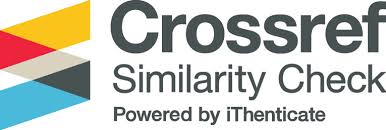Nanoemulgel Formulation of Robusta Coffee Bean Extract (Coffea canephora Pierre) With Various Gelling Agent As Antioxidant
Abstract
Antioxidants are compounds that are significant in the body's mechanism against free radicals, namely inhibiting oxidative reactions by binding to free radicals or preventing oxidative damage that can lead to oxidative stress conditions. One of the natural ingredients that have antioxidant activity is robusta coffee beans. Robusta coffee beans contain polyphenol compounds have antioxidant activity. Nanoemulgel s a gel preparation that is incorporated in a basic gel and has nano-sized particles. This study aims to 1) determine the stable formula of robusta coffee bean extract nanoemulgel with a variation of gelling agent 2) determine whether the robusta coffee bean extract nanoemulgel has antioxidant activity.
The methods used include 1) extraction with maceration 2) nanoemulsions are made using a low-performance technique (magnetic stirrer) and a high performance technique (sonicator) 3) particle size test used dynamic light scattering 4) stability parameters include pH, dispersibility, adhesion, and viscosity 5) antioxidant activity was analyzed using the DPPH method (1,1-diphenyl-2- picrylhydrazyl) 6) statistical analysis used SPSS 21 software using Paired T-test and One Way Anova.
The results nanoemulsion particle size of robusta coffee bean extract was 12.3 nm and the polydisperse index was 0.274 nm, the most stable nanoemulgel was formula 3 with varying concentrations of gelling agent (1 gram HPMC: 0.5 gram Carbopol) had an average value of pH 5, average adhesion 1.59 seconds ± 0.01, average dispersion 6.7 cm ± 0.1, and the average viscosity value of 2500 cPs. The formula with the strongest antioxidant activity is formula 1 (0.5- gram carbopol) with an average IC50 value of 10.678 ± 0.0346 ppm.
References
[2] Avachat, A. M., & Patel, V. G. (2015). Self Nanoemulsifying Drug Delivery System Of Stabilized Ellagic Acid-Phospholipid Complex With Improved Dissolution And Permeability. Saudi Pharmaceutical Journal, 23(3), 276–289. https://doi.org/10.1016/j.jsps.2014.11.001
[3] Baviskar, D. T., Biranwar, Y. A., Bare, K. R., Parik, V. B., Sapate, M. K., & Jain, D. K. (2013). In Vitro And In Vivo Evaluation Of Diclofenac Sodium Gel Prepared With Cellulose Ether And Carbopol 934P. Tropical Journal of Pharmaceutical Research, 12(4), 489–494. https://doi.org/10.4314/tjpr.v12i4.7
[4] Chairgulprasert, V., & Kongsuwankeeree, K. (2017). Preliminary Phytochemical Screening and Antioxidant Activity of Robusta Coffee. 1–8. https://doi.org/10.14456/tijsat.2017.1
[5] Depkes RI. (2000). Parameter Standar Umum Ekstrak Tumbuhan Obat. Depkes RI.
[6] Forestryana, D., Surur Fahmi, M., & Novyra Putri, A. (2020). Pengaruh Jenis dan Konsentrasi Gelling Agent pada Karakteristik Formula Gel Antiseptik Ekstrak Etanol 70% Kulit Buah Pisang Ambon. Lumbung Farmasi: Jurnal Ilmu Kefarmasian, 1(2), 45. https://doi.org/10.31764/lf.v1i2.2303
[7] Hanani, E. (2015). Analisis Fitokimia. Buku Kedokteran EGC.
[8] Herawati, H., & Sukohar, A. (2013). Pengaruh Asam Klorogenat Kopi Robusta Lampung terhadap Ekspresi Cyclin D1 dan Caspase 3 pada Cell Lines HEP-G2. Seminar Nasional Sains Dan Teknologi V, November, 533–540.
[9] Husniati, H., Sari, M. Y., & Sari, A. (2021). Kajian : Karakterisasi Senyawa Aktif Asam Klorogenat Dalam Kopi Robusta Sebagai Antioksidan Review : Characterization of active compounds in Robusta coffee as antioxidants. Teknologi Argo Industri, 12(2), 34–39.
[10] Khurana, S., Jain, N. K., & Bedi, P. M. S. (2013). Nanoemulsion Based Gel For Transdermal Delivery Of Meloxicam : Physico-chemical , mechanistic investigation. Life Sciences, 92(6–7), 383–392. https://doi.org/10.1016/j.lfs.2013.01.005
[11] Kiattisin, K., Thanaya, N., Pimporn, P. (2016). Evaluation Of Antioxidant And Anti-Tyrosane Activities As Well As Stability F Green and Roasted Coffe Bean Extracts From Coffe arabica and Coffe canephora grow in Thailand. Journal of Pharmacognosy and Phytotherapy, 8(10), 182–192. https://doi.org/10.5897/JPP2016.0413
[12] Listyorini, N. M. D., Wijayanti, N., Astuti, K. W. (2018). Optimasi Pembuatan Nanoemulsi Virgin Coconut Oil. Jurnal Kimia. Journal of Chemistry, 12(1), 8–12.
[13] Mardhiani Y., Yulianti H., A. D. (2018). Forulasi dan Stabiltas Sediaan Serum dari Ekstrak Kopi Hijau (Coffe Canephora). 2(2), 19–33.
[14] McClements, D. J. (2012). Nanoemulsions versus microemulsions: Terminology, differences, and similarities. Soft Matter, 8(6), 1719–1729. https://doi.org/10.1039/c2sm06903b
[15] Novi Fajar Utami, Nhadira Nhestricia, Sri Maryanti, Tien Tisya, S. M. (2018). Uji Aktivitas Antioksidan Dari Biji Kopi Robusta (Coffea canephora P.) Berdasarkan Perbedaan Ekologi Dataran Tinggi Di Pulau Jawa. Fitofarmaka Jurnal Ilmiah Farmasi, 8(1), 67–72.
[16] Panjaitan, R. M., Shibgatun, N., R., & Lily, A. (2015). Pemanfaatan Minyak Biji Labu Kuning (Cucurbia moschata Durch) menjadi Sediaan Nanoemulsi Topikal sebagai Agen Pengembangan Cosmetical Anti Aging. Khazanah, 7(2), 61–81.
[17] Rahman, A., Farmasi, P. S., Farmasi, F., & Surakarta, U. M. (2018). Formulasi Sediaan Nanoemulgel Ekstrak Kayu Secang (Caesalpinia sappan L.) Serta Uji Stabilitas Fisiknya. Naskah Publikasi Skripsii Universitas Muhammadiyah Surakarta
[18] Rahmayani, U., Pringgenies, D., & Djunaedi, A. (2013). Uji Aktivitas Antioksidan Ekstrak Kasar Keong Bakau (Telescopium telescopium) dengan Pelarut yang Berbeda terhadap Metode DPPH (Diphenyl Picril Hidrazil). Journal of Marine Research, 2(4), 36–45.
[19] Saputra, A. H., Haryono, A., Laksmono, J. A., & Hilman Anshari, D. M. (2011). Preparasi Koloid Nanosilver Dengan Berbagai Jenis Reduktor Sebagai Bahan Anti Bakteri. Jurnal Sains Materi Indonesia Indonesian Journal of Materials Science, 12(3), 202–208.
[20] Schneider, M., Stracke, F., Hansen, S., & Schaefer, U. F. (2009). Nanoparticles and their interactions with the dermal barrier. Dermato-Endocrinology, 1(4), 197–206. https://doi.org/10.4161/derm.1.4.9501
[21] Sinko, P. J. (2011). Colloidal dispersions (Sinko PJ.(). Lippincott Williams & Wilkins.
[22] Solanum, L., & Nsp, A. S. (2015). AKTIVITAS ANTIOKSIDAN KRIM EKSTRAK SARI TOMAT (Solanum lycopersicum L.). Traditional Medicine Journal, 18(3), 132–140. https://doi.org/10.14499/mot-TradMedJ18iss3pp132-140
[23] Susanty, S., & Bachmid, F. (2016). Perbandingan Metode Ekstraksi Maserasi Dan Refluks Terhadap Kadar Fenolik Dari Ekstrak Tongkol Jagung (Zea mays L.). Jurnal Konversi, 5(2), 87. https://doi.org/10.24853/konversi.5.2.87-92
[24] Ulaen, S., Banne, Y., & Suatan, R. (2012). Pembuatan Salep Anti Jerawat Dari Ekstrak Rimpang Temulawak (Curcuma xanthorrhiza Roxb.). Jurnal Ilmiah Farmasi Poltekkes Manado, 3(2), 96587.
[25] Utami, Y. P., Umar, A. H., Syahruni, R., & Kadullah, I. (2017). Standardisasi Simplisia dan Ekstrak Etanol Daun Leilem clerodendrum. Journal of Pharmaceutical and Medicinal Sciences, 2(1), 32–39.
[26] Wahyuningsih, I., & Putranti, W. (2015). Optimasi Perbandingan Tween 80 Dan Polietilenglikol 400 Pada Formula Self Nanoemulsifying Drug Delivery System (SNEDDS) Minyak Biji Jinten Hitam. Pharmacy, 12(02), 223–241.













